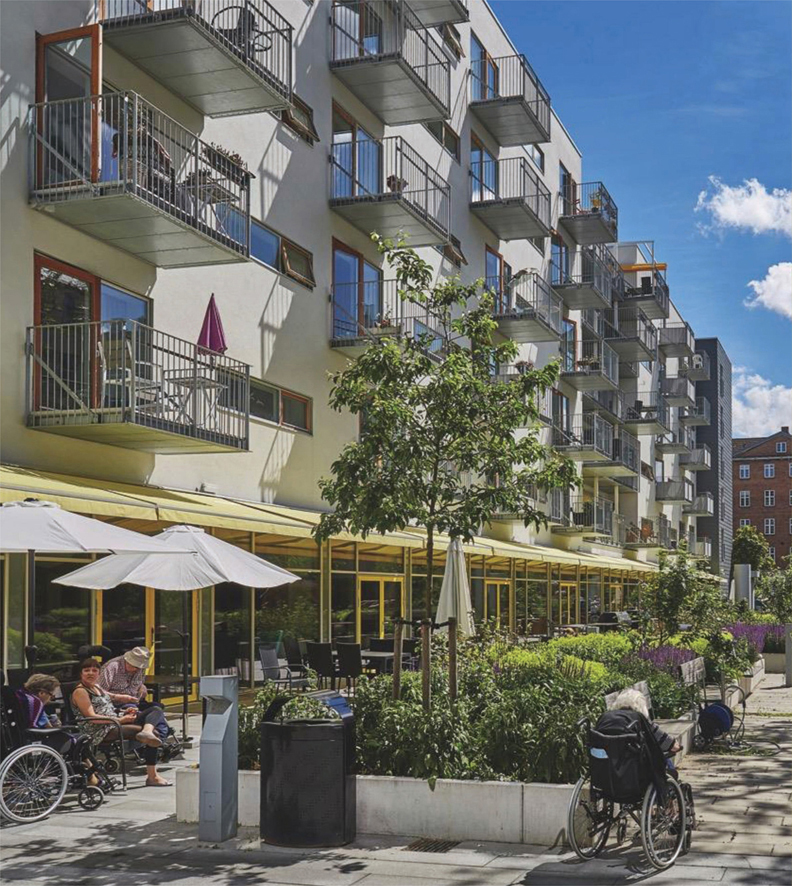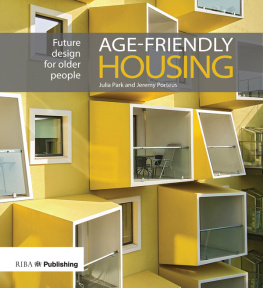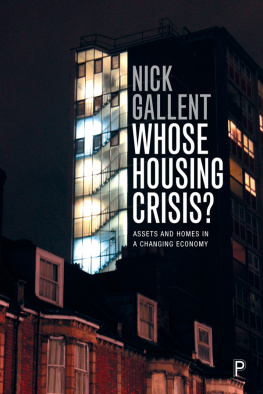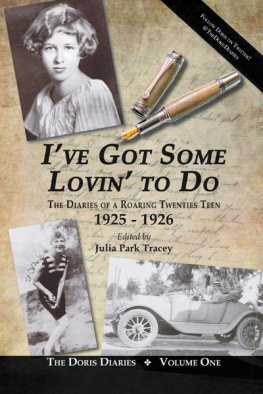Julia Park - Age-friendly Housing
Here you can read online Julia Park - Age-friendly Housing full text of the book (entire story) in english for free. Download pdf and epub, get meaning, cover and reviews about this ebook. year: 2018, publisher: RIBA Publishing, genre: Home and family. Description of the work, (preface) as well as reviews are available. Best literature library LitArk.com created for fans of good reading and offers a wide selection of genres:
Romance novel
Science fiction
Adventure
Detective
Science
History
Home and family
Prose
Art
Politics
Computer
Non-fiction
Religion
Business
Children
Humor
Choose a favorite category and find really read worthwhile books. Enjoy immersion in the world of imagination, feel the emotions of the characters or learn something new for yourself, make an fascinating discovery.
- Book:Age-friendly Housing
- Author:
- Publisher:RIBA Publishing
- Genre:
- Year:2018
- Rating:5 / 5
- Favourites:Add to favourites
- Your mark:
- 100
- 1
- 2
- 3
- 4
- 5
Age-friendly Housing: summary, description and annotation
We offer to read an annotation, description, summary or preface (depends on what the author of the book "Age-friendly Housing" wrote himself). If you haven't found the necessary information about the book — write in the comments, we will try to find it.
Age-friendly Housing — read online for free the complete book (whole text) full work
Below is the text of the book, divided by pages. System saving the place of the last page read, allows you to conveniently read the book "Age-friendly Housing" online for free, without having to search again every time where you left off. Put a bookmark, and you can go to the page where you finished reading at any time.
Font size:
Interval:
Bookmark:
The Adaptation and Resilience in the Context of Change (ARCC) network, Are you interested in improved health and wellbeing for our ageing society? (nd), http://www.arcc-network.org.uk/health-wellbeing/ageing-mobility/ (accessed 8 February 2018).
Matthew Barac and Julia Park, J. Housing Our Ageing Population: Panel for innovation , Homes and Communities Agency, 2009, https://www.gov.uk/government/uploads/system/uploads/attachment_data/file/378171/happi_final_report_-_031209.pdf (accessed 15 February 2018).
Richard Best and Jeremy Porteus, Housing Our Ageing Population: Positive ideas (HAPPI 3) , APPG inquiry report, Housing LIN, 2017, https://www.housinglin.org.uk/_assets/Resources/Housing/Support_materials/Other_reports_and_guidance/HAPPI3_Report_2016.pdf (accessed 10 February 2018).
Sam Clark. Retirement Living Explained: A guide for planning and design professionals , Churchill Retirement Living, 2017, https://www.churchillretirement.co.uk/assets/Retirement-Living-Explained-Planning-Report-web.pdf (accessed 15 February 2018).
Ian Copeman and Jeremy Porteus. J. Housing Our Ageing Population: Learning from councils meeting the needs of our ageing population , Local Government Association, 2017, https://www.local.gov.uk/sites/default/files/documents/5.17%20-%20Housing%20our%20ageing%20population_07_0.pdf (accessed 15 February 2017).
Foresight, Future of an Ageing Population , Government Office for Science, 2016, https://www.gov.uk/government/uploads/system/uploads/attachment_data/file/535187/gs-16-10-future-of-an-ageing-population.pdf (accessed 15 February 2018).
Habinteg, Wheelchair Housing Design Guide (3rd edn), RIBA Publishing, 2018.
Bill Halsall and Dr Rob MacDonald. R. Design for Dementia: Volume 1 A Guide , The Halsall Lloyd Partnership, 2015, http://www.hlpdesign.com/images/case_studies/Vol1.pdf (accessed 14 February 2018).
Bill Halsall and Dr Rob MacDonald. R. Design for Dementia: Volume 2 Research Projects , The Halsall Lloyd Partnership, 2015, http://www.hlpdesign.com/images/case_studies/Vol2.pdf (accessed 14 February 2018).
Sophie Handler. An Alternative Age-Friendly Handbook , RIBA/UK Urban Ageing Consortium/MICRA/Age UK, 2016, https://www.architecture.com/knowledge-and-resources/resources-landing-page/age-friendly-handbook (accessed 15 February 2018).
Ed Harding. Towards Lifetime Neighbourhoods: Designing sustainable communities for all. International Longevity Centre UK and Department for Communities and Local Government, November 2007, http://www.ilc-alliance.org/images/uploads/publication-pdfs/pdf_pdf_40.pdf (accessed 8 February 2018).
Homes and Communities Agency, Non-Mainstream Housing Design Guidance: Literature review , HCA, 2012, http://webarchive.nationalarchives.gov.uk/20140805123756/ https://www.homesandcommunities.co.uk/download-doc/6434/10967 (accessed 15 February 2018).
House of Commons, Communities and Local Government Committee, Housing for Older People , Second Report of Session 201719, HC 370, 5 February 2018, https://publications.parliament.uk/pa/cm201719/cmselect/cmcomloc/370/370.pdf (accessed 9 February 2018).
Legal and General Group, Last Time Buyers , Legal & General/CEBR, December 2015, https://www.legalandgeneralgroup.com/assets/portal/files/pdf_175.pdf (accessed 15 February 2018).
Lloyd, J. Valuing Retirement Housing: Exploring the economic effects of specialist housing for older people , Strategic Society Centre, August 2016, http://strategicsociety.org.uk/wp-content/uploads/2016/08/Valuing-Retirement-Housing.pdf (accessed 15 February 2018).
National House Building Council Foundation, The Connected Home: Designing and building technology into todays new homes , NHBC Foundation, 2016, https://www.nhbcfoundation.org/publication/the-connected-home/ (accessed 15 February 2018).
National House Building Council Foundation, Moving Insights from the Over-55s: What homes do they buy? , NHBC Foundation, 2017, https://www.nhbcfoundation.org/publication/moving-insights-from-the-over-55s-what-homes-do-they-buy/ (accessed 15 February 2018).
Adam Park, Friederike Ziegler and Sarah Wigglesworth, Designing with Downsizers: The next generation of downsizer homes for an active third age (DWELL) , 2016, University of Sheffield / Housing LIN, https://www.housinglin.org.uk/_assets/DWELL_DesigningWithDownsizers.pdf (accessed 15 February 2018).
James Parkinson, Will Hunter, Matthew Barac, Silver Linings: The active third age and the city , RIBA, 2013, http://www.buildingfutures.org.uk/assets/downloads/MID_RIBA_Silver_linings_161013_v2.pdf (accessed 4 July 2017).
Royal Town Planning Institute, Dementia and Town Planning: Creating better environments for people living with dementia , RTPI, 2017, http://www.rtpi.org.uk/media/2213533/dementia_and_town_planning_final.compressed.pdf (accessed 16 February 2018).
David Sinclair and Helen Creighton. Opportunity Knocks: Designing solutions for an ageing society , International Longevity Centre UK, 2015, http://www.ilcuk.org.uk/index.php/publications/publication_details/opportunity_knocks_designing_solutions_for_an_ageing_society (accessed 16 February 2018).
Sonia Sodha. Silver Chic: The future of retirement housing and care , Anchor Trust, 2015, http://www.anchor.org.uk/sites/default/files/news_articles/documents/Silver%20Chic.Final_.pdf (accessed 16 February 2018).
Damian Utton. Designing Homes for People with Dementia . Hawker Publications Ltd, 2006.
Claudia Wood, The Top of the Ladder , Demos, 2013, https://www.demos.co.uk/files/TopoftheLadder-web.pdf?1378922386 (accessed 8 February 2018).
Claudia Wood. Unlocking the Housing Market: Helping first time buyers by helping later life buyers , Demos, 2017, https://www.demos.co.uk/wp-content/uploads/2017/11/Unlocking-the-Market-Demos-Report.pdf (accessed 16 February 20818).
Womens Royal Voluntary Service (WRVS), Gold Age Pensioners: Valuing the socio-economic contribution of older people in the UK , March 2011, https://www.royalvoluntaryservice.org.uk/Uploads/Documents/gold_age_report_2011.pdf (accessed 10 February 2018).
Introduction

Getting old remains a conundrum. None of us wants to die but few of us look forward to being old. This opening chapter provides a context for addressing the challenge of how we can continue to live well as we live longer. Having set out the scale of the challenge, it looks at some perceptions of ageing, and the physical and cognitive effects of getting older, as a useful starting point for design.
A brief history of housing for older people reminds us that progress has been painfully slow. For centuries, older people with limited means relied on almshouses when they could no longer manage alone. Real change began about a hundred years ago, and more recently, the HAPPI project made its mark, pointing out that opportunity is often the corollary to challenge. The concept of inclusive design is discussed, followed by a brief overview of recent government policy.
Across the world, demography is changing. The most significant factors are lower birth rates and longer lifespans. The average household size in England is now only 2.3 people, compared with 4.8 at the start of the 20th century.
Current average life expectancy in the UK is 83 for women and 79 for men. In 1901 it was 49 and 45 respectively. Much has been made of this in the media and we see it for ourselves, but as a society, and as a profession, we have been slow to react, particularly in terms of planning for the implications for housing, health and social care.
Current average life expectancy in the UK is 83 for women and 79 for men. In 1901 it was 49 and 45 respectively.
Font size:
Interval:
Bookmark:
Similar books «Age-friendly Housing»
Look at similar books to Age-friendly Housing. We have selected literature similar in name and meaning in the hope of providing readers with more options to find new, interesting, not yet read works.
Discussion, reviews of the book Age-friendly Housing and just readers' own opinions. Leave your comments, write what you think about the work, its meaning or the main characters. Specify what exactly you liked and what you didn't like, and why you think so.







